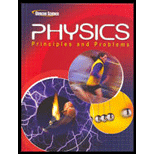FREE Answers for Glencoe Physics: Principles and Problems, Student Edition
Q & A
Stuck on your homework?
Ask a question and get an expertly curated answer in as fast as 30 minutes.*
*Response times may vary by subject and question complexity. Median response time is 34 minutes for paid subscribers and may be longer for promotional offers and new subjects.
Browse All Chapters of This Textbook
Book Details
Accelerate student learning with the perfect blend of content and problem-solving strategies! Physics: Principles and Problems offers integrated support, abundant opportunities for problem solving, and a variety of realistic applications. The program has a balance of good conceptual presentation with a strong problem-solving strand. The program resources are organized in a way that saves you preparation time and allows you to meet the needs of students in your diverse classroom. New for 2009 features include more problems - Supplemental Problems, Challenge Problems, Pre-AP/Critical Thinking Problems and practice for end-of-course exams - , better math support with unique Example Problems that offer "coaching notes" to aid comprehension, and Teacher-tested lab options!
More Editions of This Book
Corresponding editions of this textbook are also available below:
